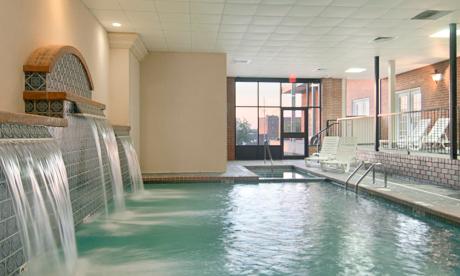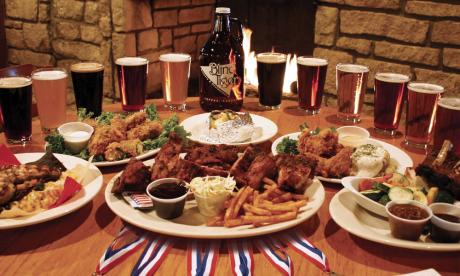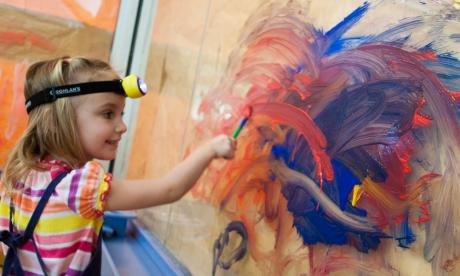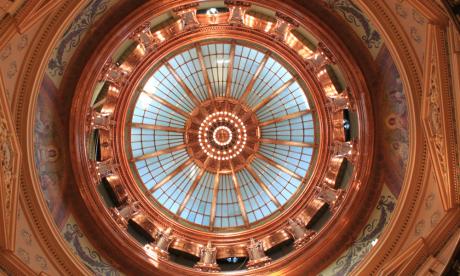History of the Kansas Statehouse
A LABOR OF LOVE
In the late 1800s, more than one million people streamed into Kansas seeking a new life on the frontier. As they arrived, what they saw was amazing. Rising from the Kansas prairie, a grand building loomed over the growing city and welcomed settlers. Along Topeka's dirt streets, the sound of chipping stone was a constant rhythm as construction on the Kansas Statehouse continued for 37 years. The building cost $3.2 million to build and included architectural elements of gleaming copper and 17 types of marble, crystal, granite and gold leaf paint. The Capitol was added to the National Register of Historic Places in 1971.
The north entrance of the Statehouse is now a welcoming public entrance, as it was originally intended. The visitor's center includes a modern classroom, an orientation auditorium, display space for exhibits and a gift shop with one-of-a-kind Kansas-made products. Don't miss the souvenirs and jewelry made from the original green copper dome. A consultant hired to assess Topeka's historic preservation plan was so stunned by the newly renovated Statehouse that she urged city leaders to apply for "world heritage site" designation, which would add the Capitol to an exclusive list of cultural and natural sites worldwide, such as Grand Canyon National Park, Independence Hall and Mesa Verde National Park.
The History of the Kansas State Capitol
By the Kansas Historical Society
The Kansas State Capitol is located on a 20-acre tract in downtown Topeka. Its distinctive copper dome with Ad Astra statue is a prominent feature of the city skyline.
 The site was donated through the efforts of Cyrus K. Holliday, president of the early Topeka Town Company and one of the founders of the Atchison, Topeka & Santa Fe Railway. In 1862 the company donated what has become known as Capitol Square. On February 7, 1862, the legislature accepted the donation and authorized a building design by architect Edward Townsend Mix of Milwaukee, Wisconsin. Mix's concept for the Capitol was more than 300,000 square feet inspired by classical architecture and featuring a mansard roof.
The site was donated through the efforts of Cyrus K. Holliday, president of the early Topeka Town Company and one of the founders of the Atchison, Topeka & Santa Fe Railway. In 1862 the company donated what has become known as Capitol Square. On February 7, 1862, the legislature accepted the donation and authorized a building design by architect Edward Townsend Mix of Milwaukee, Wisconsin. Mix's concept for the Capitol was more than 300,000 square feet inspired by classical architecture and featuring a mansard roof.
In 1866 the state legislature passed House Bill 34 "An Act Providing for the Erection of the Statehouse." On February 14, 1866, Governor Samuel Crawford signed the bill into law. The statehouse committee also reviewed a concept from Kansas architect John G. Haskell, which Governor Crawford preferred. Haskell was hired as architect for the project and he made a number of changes to Mix's original design. The committee wanted the building to be fire resistant, to use natural lighting, and to attach the wings similar to the U.S. Capitol. The committee also wanted to incorporate the heating and ventilation techniques of monuments in the East. They authorized Haskell to explore other sites but to travel no farther east than Philadelphia. Haskell chose a classical style that was intended to give dignity to state government.
They began a search for appropriate building stone of sufficient quantity and accessible to transport to the building site in a timely manner. Limestone was identified near Manhattan in Riley County that would be appropriate, but no railroads existed to transport the stone to Topeka. They instead selected brown stone from a quarry on the bluffs along Deer Creek southeast of Topeka.
The east wing cornerstone was laid October 17, 1866. The brown stone did not harden sufficiently between quarrying and construction. Following a harsh winter in 1867, the cornerstone and foundation of the wing crumbled.
The stone was removed and harder limestone from Geary County was used to replace the foundation and continue construction on the wing. Limestone from Cottonwood Falls was selected for use elsewhere in the construction.
In 1869, while construction was still underway, state offices were moved to the new Capitol building from the Old Constitution Hall, now 427-429 Kansas Avenue. The legislature first met in the new Capitol in 1870. The east wing was finally completed in 1873 at a total construction cost reported at $480,000.
Work on the west wing, which is wider and longer than the east wing, was begun in 1879 and enclosed by 1880. A covered wood bridge, called the Cave of the Winds because of the draftiness, connected the two wings before the central building was in place. Limestone from Cottonwood Falls was used for the west wing. The wing was still under construction when the Kansas House of Representatives convened in 1881. The total cost of construction for the west wing was reported at $317,000.
Construction on the north and south wings began in 1883. The Senate chamber was remodeled in 1885 while the central building was under construction. Workers identified what they thought was a spring while digging the 25-foot deep foundation. Recent studies show the moisture seeps into the bedrock from the Kansas River. The contract for the roof and dome was let in 1889. A crack, caused by settling of the foundation, was repaired in 1890. With the emergence of the Populist Party in the 1890s, construction on the interior was interrupted.
Concepts for artwork in the Capitol's interior changed over the years. The original plans called for a fountain to be placed on the first floor rotunda; sculptures in the north and south pediments; and a large statue of Ceres, the Roman goddess of vegetation, to be mounted atop the dome. Eventually, murals were added to the first floor, second floor, and fifth floor. Some of the original artwork became controversial and was replaced. Read more about specific artwork in the Capitol.
Construction on the Capitol took 37 years; the building was officially completed March 24, 1903. The total cost was $3,200,588.92.
Today the Kansas State Capitol is an impressive public monument as well as the working offices for the governor and legislators. A Kaw warrior, Ad Astra, was placed atop the dome in 2002, statues of four famous Kansans are located on the second floor rotunda, and murals by several Kansas artists are featured throughout the building. Several statues and memorials adorn the grounds. The building was listed in the National Register of Historic Places in 1971.
Building dimensions
The Capitol measures 399 feet north and south and 386 feet east and west. It stands 306 feet from the ground to the top of Ad Astra's bow. The west wing is four feet wider and six feet longer than the east wing. The dome is 66.5 feet in diameter at the bottom of the copper dome and 54.5 feet from the beginning of the copper dome to the cupola floor. The cupola height is 23.5 feet. The Kansas State Capitol is approximately 17 feet higher than the U.S. Capitol in Washington, D.C.








